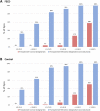Clinical Outcomes of Toric Intraocular Lenses in Patients with Fuchs Endothelial Corneal Dystrophy
- PMID: 37052875
- PMCID: PMC10164209
- DOI: 10.1007/s40123-023-00700-5
Clinical Outcomes of Toric Intraocular Lenses in Patients with Fuchs Endothelial Corneal Dystrophy
Abstract
Introduction: Implantation of toric intraocular lenses (IOLs) in patients with Fuchs endothelial corneal dystrophy (FECD) is still considered relatively contraindicated, without sufficient clinical evidence. Therefore, this study was designed to evaluate the results of toric IOL implantation in patients with FECD.
Methods: A retrospective case-control study of 28 eyes of FECD patients and 84 eyes of healthy control patients who received toric IOLs during routine cataract surgery was performed. The outcome measures were uncorrected and corrected distance visual acuity, spherical equivalent, and refractive residual astigmatism.
Results: The mean postoperative uncorrected and corrected distance visual acuity in the FECD eyes compared to the control eyes were 0.15 ± 0.14 vs. 0.13 ± 0.17, respectively (P = 0.32), and 0.05 ± 0.08 vs. 0.06 ± 0.10, respectively (P = 0.95). The spherical equivalent in the FECD eyes compared to the control eyes was - 0.29 ± 0.43 vs. - 0.21 ± 0.50, respectively (P = 0.19). The preoperative corneal centroid astigmatism in the FECD eyes compared to the control eyes was 0.85 D@93° ± 2.42° vs. 0.23 D@68° ± 2.50°, respectively (P = 0.43), and the mean preoperative corneal astigmatism magnitude was 2.26 ± 1.1 D vs. 2.28 ± 1.03 D, respectively (P = 0.82). A trend toward higher postoperative refractive centroid astigmatism was found in the FECD eyes compared with the control eyes: 0.24 D@28° ± 0.57° vs. 0.03 D@127° ± 0.53°, respectively (P = 0.09). However, the mean refractive astigmatism magnitude was similar in FECD eyes and the healthy control eyes: 0.52 ± 0.31 D vs. 0.42 ± 0.31 D, respectively (P = 0.44) (D diopters).
Conclusion: The postoperative refractive astigmatism (both centroid astigmatism and mean magnitude astigmatism) was no higher than 0.52 D in both groups. Therefore, FECD patients without corneal edema can be considered for toric IOLs.
Keywords: Cornea; Dystrophy; Fuchs; Intraocular lens; Toric.
© 2023. The Author(s).
Conflict of interest statement
Prof. Assia is a consultant for Hanita Lenses, Vision Care Technologies; is founder and CMO of APX Ophthalmology and VisiDome; and is a shareholder in IOPtima and CorNeat. Prof. Kleinmann is a consultant for Hanita Lenses, Johnson and Johnson Vision and CorNeat. Michal Blau-Most and Adi Levy have nothing to disclose.
Figures
Similar articles
-
Phakic intraocular lenses for the treatment of refractive errors: an evidence-based analysis.Ont Health Technol Assess Ser. 2009;9(14):1-120. Epub 2009 Oct 1. Ont Health Technol Assess Ser. 2009. PMID: 23074518 Free PMC article.
-
Toric intraocular lens versus limbal relaxing incisions for corneal astigmatism after phacoemulsification.Cochrane Database Syst Rev. 2019 Dec 17;12(12):CD012801. doi: 10.1002/14651858.CD012801.pub2. Cochrane Database Syst Rev. 2019. PMID: 31845757 Free PMC article.
-
Astigmatism Correction With Toric Intraocular Lenses in Descemet Membrane Endothelial Keratoplasty Triple Procedures.Cornea. 2017 Mar;36(3):269-274. doi: 10.1097/ICO.0000000000001124. Cornea. 2017. PMID: 28002107
-
Effect of Toric Intraocular Lens Implantation on Visual Acuity and Astigmatism Status in Eyes Treated With Microhook Ab Interno Trabeculotomy.J Glaucoma. 2021 Jan 1;30(1):94-100. doi: 10.1097/IJG.0000000000001705. J Glaucoma. 2021. PMID: 33031190
-
Supplemental Toric Intraocular Lenses in the Ciliary Sulcus for Correction of Residual Refractive Astigmatism: A Review.Ophthalmol Ther. 2023 Aug;12(4):1813-1826. doi: 10.1007/s40123-023-00721-0. Epub 2023 May 5. Ophthalmol Ther. 2023. PMID: 37145259 Free PMC article. Review.
References
LinkOut - more resources
Full Text Sources


